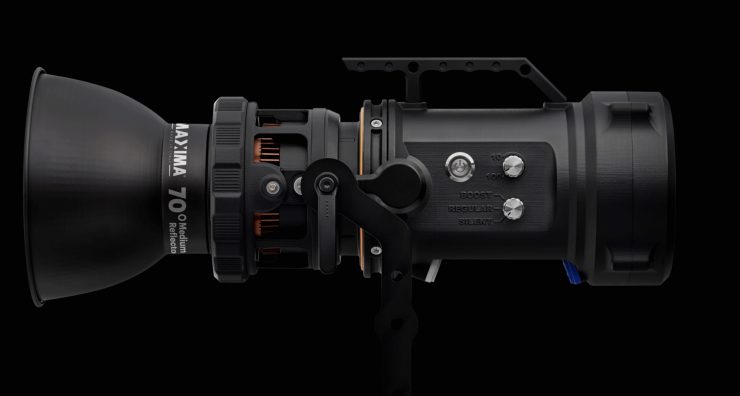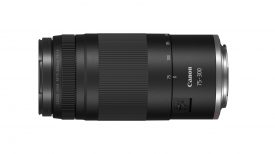The Maxima 6 GaN packs more than 60,000 lumens in the same, all-in-one convenient form factor of the original Maxima 3. It also has the same high color accuracy (98.3 CRI) with superior cooling technology and all-weather resistance. The Maxima 6 GaN is an extremely bright and compact, directional LED fixture with an output comparable to that of conventional technology 700W LEDs.

The company is also claiming that it has the quietest noise footprint in the market. According to Maxima, all of this was made possible by adopting next-gen Gallium Nitride (GaN) circuitry. At least to my knowledge, this is the first time ever this has been used with lighting equipment in our industry.

Key features
- 4kg weight, all-in-one compact design with no external ballast;
- Noiseless operation;
- 69000 lumens, just 600W consumption;
- 99 TLCI, 98 CRI with R9 94 and R12 97;
- 5600°K, full-spectrum white light;
- Superior white point accuracy with no green/ magenta color shifts;
- Exceptional long term color stability with 0.2% color shift after 25.000 hours of usage;
- Patented, full copper heatsink that enables silent operations up to 65% of total luminous output;
- Full power DC battery operation with any third-party power source from 35V to 75V;
- Removable, low dispersion aspherical lens with hyperbolic curvature for improved light filling of softboxes and conical reflectors;
- 3 operating modes: Silent (up to 350W) Regular (up to 450W) Boost (up to 600W);
- Bluetooth and DMX512 connectivity;
- Flicker-free up to 200000 fps;
- Weather-proof;
- Modular, upgradeable design;
- Environmentally friendly and compliant with EU regulations.
- Made in Italy

The Maxima 6 GaN is the follow-up to the Maxima 3. I reviewed the smaller Maxima 3 on the site last year. I found that the Maxima 3 was a well-made, well-thought-out fixture with exceptionally good color accuracy and a decent amount of output. I liked the all-in-one design and the attention to detail.
The fixture produces a really nice quality of light and I also liked how quickly you can go from using the Fresnel to a softbox.

The Maxima 6 GaN is natively compatible with all Profoto RFI and Bowens S mount accessories. In another industry first, it is also compatible with the ARRI QLM system. This allows you to attach ARRI Orbiter optics to the fixture. There is also no need for an adapter for Profoto accessories since they will fit natively to the OmniMount.

A Fresnel lens will come as an accessory by the end of 2023.
What is GaN?
The Maxima 6 GaN is the world’s first LED lamp driven by gallium nitride circuitry, which makes it capable of an unprecedented lux-to-weight ratio, best-in-class efficiency, and high CRI color rendition. GaN semiconductors are inherently more efficient than silicon, so less energy is expended as heat, resulting in a more efficient system with a higher power density (smaller volume).
According to Maxima, the patented, full copper heatsink combined with advanced thermal management brings Maxima 6 GaN to the top levels of performance charts, both in terms of brightness and compactness.
The increased efficiency obtained with GaN circuitry and the innovative thermal management subsystem guarantees consistency and peak performance for years.
Thanks to the Gallium Nitride circuitry, you can operate the Maxima 6 GaN with any third-party DC source (like Bebop, FXLion, Arri,…) from 35 to 75 V.
Gallium Nitride is a binary III/V direct bandgap semiconductor that is well-suited for high-power transistors capable of operating at high temperatures. Since the 1990s, it has been used commonly in light-emitting diodes (LED). Gallium nitride gives off a blue light used for disc-reading in Blu-ray. Additionally, gallium nitride is used in semiconductor power devices, RF components, lasers, and photonics. In the future, we will see GaN in sensor technology.
In 2006, enhancement-mode GaN transistors, sometimes referred to as GaN FETs, started being manufactured by growing a thin layer of GaN on the AIN layer of a standard silicon wafer using metal organic chemical vapor deposition (MOCVD). The AIN layer acts as a buffer between the substrate and GaN. This new process enabled gallium nitride transistors to be producible in the same existing factories as silicon, using almost the same manufacturing processes. Using a known process, allows for similar, low manufacturing costs and reduces the barrier to adoption for smaller transistors with much-improved performance.
To further explain, all semiconductor materials have what is called a bandgap. This is an energy range in a solid where no electrons can exist. Simply put, a bandgap is related to how well a solid material can conduct electricity. Gallium nitride has a 3.4 eV bandgap, compared to silicon’s 1.12 eV bandgap. Gallium nitride’s wider band gap means it can sustain higher voltages and higher temperatures than silicon MOSFETs. This wide bandgap enables gallium nitride to be applied to optoelectronic high-power and high-frequency devices.
The ability to operate at much higher temperatures and voltages than gallium arsenide (GaAs) transistors also makes gallium nitride ideal power amplifiers for microwave and terahertz (ThZ) devices, such as imaging and sensing, the future market mentioned above.
ADVANTAGES OF GALLIUM NITRIDE
The value proposition for GaN devices consists of four major points:
Reduced energy costs – Because GaN semiconductors are inherently more efficient than silicon, less energy is expended as heat, resulting in smaller system sizes and material costs.
Higher power density (smaller volume) – Higher switching frequencies and operational temperatures than silicon result in lower cooling requirements, smaller heat sinks, conversion from liquid-cooling to air cooling, eliminating fans and reduced magnetics.
Higher switching frequency – The higher switching frequencies for GaN devices allow smaller inductors and capacitors to be used in power circuits. The inductance and capacitance scale down in proportion to the frequency – a 10X increase in frequency produces a 10X decrease in the capacitance and inductance. This can result in an enormous decrease in weight and volume, as well as cost. In addition, higher frequency can result in less acoustic noise in motor drive applications. High frequency also enables wireless power transfer at higher powers, more spatial freedom and bigger transmit to receive airgaps.
Lower system cost – While GaN semiconductors are generally higher cost than silicon, system-level cost reductions result through the use of GaN by reducing the size/costs of other components such as passive inductive and capacitive circuit elements, filters, cooling, etc. Savings range from 10-20%.
Output

Above you can see the claimed output of the Maxima 6 GaN when it is used open face, with its 70-degree reflector, and with the ARRI QLM 15 and 30-degree optics.
If you want a comparison when it comes to output, the ARRI Orbiter when using its 15-degree QLM optic puts out 85,400 lx (7930 fc) @1m /3.3′. The claimed output of the Maxima 6 GaN using that exact same optic is a whopping 283,500 lx at the same distance.
Maxima has also extended the flicker-free performance from 10,000 fps to over 30,000 fps and they have improved the Bluetooth speed when using the app.
Color Rendering



Above you can see the very impressive (claimed) color rendering scores, White Point, TM-30, and spectral response of the Maxima 6 GaN.
Weight & Size

The Maxima 6 GaN weighs 4.6kg / 10.14 lb with its yoke frame.
Specifications


The fixture is designed and manufactured in Italy and it comes with the addition of a 2- years warranty.
Price & Availability
The Maxima 6 GaN will retail for 2.999 Euros, including the waterproof Flight Case and the Bowens adapter.
Accessories

Maxima also sells a range of accessories for he fixture. Some of them you can see above.
Thoughts
The Maxima 6 GaN looks like a very impressive fixture, given its size, weight, output, and claimed color rendering scores.
It is always great to see new technology making its way into professional lighting. I also like that companies such as Maxima are not just making lights with unique features and not just making a copy of an existing light like we so often see.























